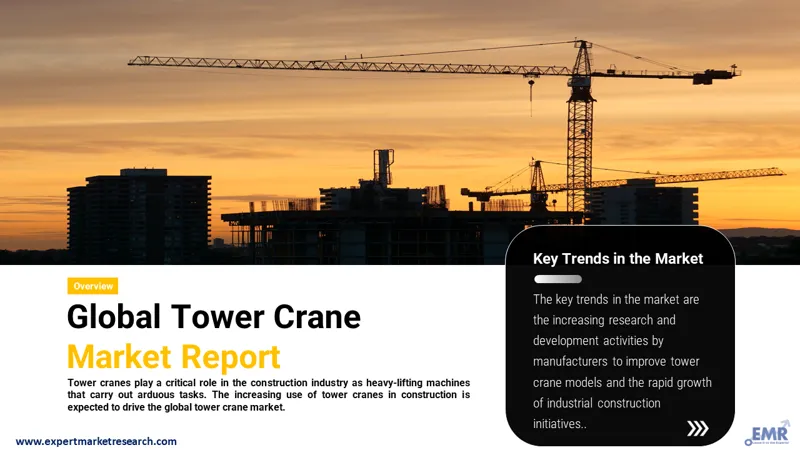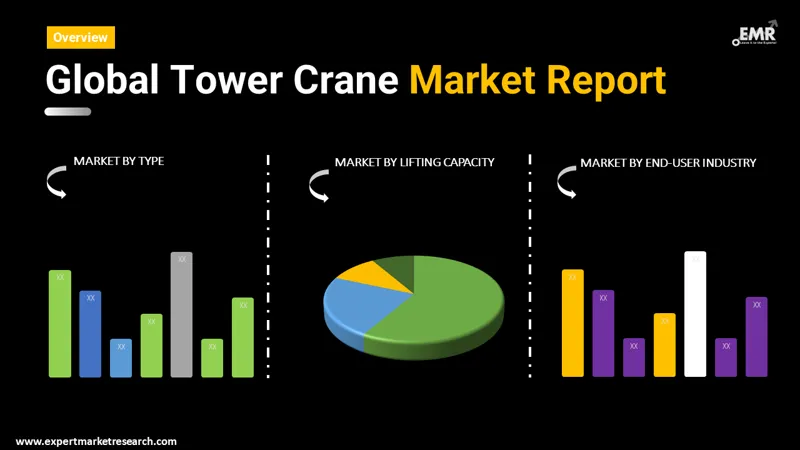
Consumer Insights
Uncover trends and behaviors shaping consumer choices today
Procurement Insights
Optimize your sourcing strategy with key market data
Industry Stats
Stay ahead with the latest trends and market analysis.
The global tower crane market would likely grow at a CAGR of 4.50% during 2026-2035. Tower cranes are extensively used in building projects; the machines are used to lift heavy loads such as concrete and steel. Large devices like generators, motors, and acetylene torches are also moved with the help of tower cranes. Uses of tower cranes include dam construction; bridge construction; civil construction; residential construction; industry, plant, and automation; power plant; railway; marine construction; etc. Asia, North America and Europe are likely to be key markets.
Base Year
Historical Period
Forecast Period
Compound Annual Growth Rate
4.5%
2026-2035
*this image is indicative*
Modern tower cranes enable development companies to work more efficiently, quickly, sustainably and cost-effectively. These heavy-lifting machines are very useful in carrying out arduous tasks. Tower cranes are particularly vital to the construction industry. Uses in construction are expected to boost the global tower crane market.
Tower cranes are commonly used at construction sites across the world; projects requiring heavy lifting at great heights warrant tower cranes. The essential elements of a tower crane include base support (positioned at the tower bottom, generally connected to a concrete pad on the ground; it may also be connected to a ballasted chassis or steel grillage set on ground or atop a present structure), tower (also called mast, it is a vertical component affording the crane its height), turntable (allows the crane arm to rotate), operator’s cab (box in which the operator sits), jib or working arm (supports and positions the lifted load), trolley and hook block (trolley moves front and back across the jib; hook block acts as pulley system enabling the hook to move up and down), counter jib (helps the machine maintain balance), and counterweight (helps balance the load of the lift).

Read more about this report - REQUEST FREE SAMPLE COPY IN PDF
Different types of tower cranes include Hammerhead Tower Crane, Luffing Jib Crane, and Self-erecting Crane. Appropriate projects for tower crane use include, Multi-Family Housing, Hospitals and Educational Facilities, Parking Garages, Water Treatment Facilities, Mid/High Rise Construction, Industrial Projects, etc. Such uses are expected to boost the global tower crane market.
In 2022, it was reported that Bennetts Cranes took delivery of the first Saez SL 730 – the largest luffing jib model in the Saez tower crane fleet; the machine had a 36,000kg (36 tonne) maximum load. Bennetts was the first hire company in the world to acquire the new model.
In 2021, it was reported that the tallest freestanding luffing jib crane operating in the UK reached final height. Bennetts Cranes increased freestanding crane to 105m for residential development in Fulham. This was seen as the tallest freestanding luffing jib crane in operation in the UK at the time, implying it was not tied to the building.
In 2022, it was reported that BKL was helping in setting up the new Terminal 3 at Fraport in Germany with the help of twelve tower cranes and many mobile crane operations. It was one among Europe’s biggest privately funded infrastructure projects.
In 2022, it was reported that the new Potain MCT 805 (a high-capacity flat top tower crane) would soon be available in Australia, Asia, the Middle East, New Zealand, Africa and Latin America. Nearly twelve Potain cranes were employed to advance the construction of an important residential development in Mamurdi, northwest Pune, Maharashtra.
The EMR’s report titled “Tower Crane Market Report and Forecast 2026-2035” offers a detailed analysis of the market based on the following segments:
By type, the global market is segmented into:
By lifting capacity, the market is divided into:
By end user industry, the market is classified into:
By region, the market is divided into:

Read more about this report - REQUEST FREE SAMPLE COPY IN PDF
The report offers an extensive assessment of major players in the global tower crane market; it evaluates their capability, observes latest occurrences such as mergers and acquisitions, capacity expansions, and plant turnarounds:
Using SWOT analysis and Porter’s Five Forces model, the EMR report offers deep insights into the industry.




*While we strive to always give you current and accurate information, the numbers depicted on the website are indicative and may differ from the actual numbers in the main report. At Expert Market Research, we aim to bring you the latest insights and trends in the market. Using our analyses and forecasts, stakeholders can understand the market dynamics, navigate challenges, and capitalize on opportunities to make data-driven strategic decisions.*
Get in touch with us for a customized solution tailored to your unique requirements and save upto 35%!
The market is estimated to grow at a CAGR of 4.50% in the forecast period of between 2026 and 2035.
The major drivers of the market include the increasing demand for construction machines capable of moving heavy loads, expansion of the construction sector across emerging economies, and growing renovation initiatives.
The growing research and development activities by the manufacturers aimed towards improving the models of tower crane and rapid industrial construction initiatives are the key trends in the market.
Hammerhead, luffing jib, flat top, and self-erecting are the different segments in the tower crane market based on type.
Less than 5 ton, 6 to 10 ton, and more than 10 ton are the different categories based on lifting capacity.
The cost of a tower crane depends upon the radius of the product. For instance, tower cranes of radius 48-60 m can have a price range of between USD 41,000 and USD 48,000.
A tower crane is generally used for mobilising heavy loads in the construction sector. It can anchor loads which are humanly impossible to lift.
The primary end-user industries for tower cranes are infrastructural construction, energy, and building construction, among others.
Explore our key highlights of the report and gain a concise overview of key findings, trends, and actionable insights that will empower your strategic decisions.
| REPORT FEATURES | DETAILS |
| Base Year | 2025 |
| Historical Period | 2019-2025 |
| Forecast Period | 2026-2035 |
| Scope of the Report |
Historical and Forecast Trends, Industry Drivers and Constraints, Historical and Forecast Market Analysis by Segment:
|
| Breakup by Type |
|
| Breakup by Lifting Capacity |
|
| Breakup by End-User Industry |
|
| Breakup by Region |
|
| Market Dynamics |
|
| Trade Data Analysis |
|
| Competitive Landscape |
|
| Companies Covered |
|
Datasheet
One User
USD 2,499
USD 2,249
tax inclusive*
Single User License
One User
USD 3,999
USD 3,599
tax inclusive*
Five User License
Five User
USD 4,999
USD 4,249
tax inclusive*
Corporate License
Unlimited Users
USD 5,999
USD 5,099
tax inclusive*
*Please note that the prices mentioned below are starting prices for each bundle type. Kindly contact our team for further details.*
Flash Bundle
Small Business Bundle
Growth Bundle
Enterprise Bundle
*Please note that the prices mentioned below are starting prices for each bundle type. Kindly contact our team for further details.*
Flash Bundle
Number of Reports: 3
20%
tax inclusive*
Small Business Bundle
Number of Reports: 5
25%
tax inclusive*
Growth Bundle
Number of Reports: 8
30%
tax inclusive*
Enterprise Bundle
Number of Reports: 10
35%
tax inclusive*
How To Order

Select License Type
Choose the right license for your needs and access rights.

Click on ‘Buy Now’
Add the report to your cart with one click and proceed to register.

Select Mode of Payment
Choose a payment option for a secure checkout. You will be redirected accordingly.
Gain insights to stay ahead and seize opportunities.

Get insights & trends for a competitive edge.

Track prices with detailed trend reports.

Analyse trade data for supply chain insights.

Leverage cost reports for smart savings

Enhance supply chain with partnerships.

Connect For More Information
Our expert team of analysts will offer full support and resolve any queries regarding the report, before and after the purchase.
Our expert team of analysts will offer full support and resolve any queries regarding the report, before and after the purchase.
We employ meticulous research methods, blending advanced analytics and expert insights to deliver accurate, actionable industry intelligence, staying ahead of competitors.
Our skilled analysts offer unparalleled competitive advantage with detailed insights on current and emerging markets, ensuring your strategic edge.
We offer an in-depth yet simplified presentation of industry insights and analysis to meet your specific requirements effectively.
Share